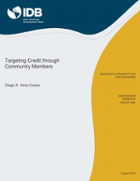Targeting Credit through Community Members
Date
Aug 2018
Summary
Decentralizing the allocation of resources to community members is an increasingly popular form of delivering public resources in developing countries. However, this approach is associated with the tradeoff between improved information about potential beneficiaries and favoritism towards local elites, which could be strengthened in the context of credit. Unlike targeting cash transfers at poor households, allocating publicly-provided credit is a more complex problem involving issues of risk, neediness, productivity, and market responses: This paper analyzes this problem using a large-scale lending program, the Thai Million Baht Credit Fund, which decentralizes the allocation of loans to an elected group of community members, and provides three main results. First, exploiting a long and detailed panel, I recover pre-program structural estimates of household productivity and find that neither repayment, nor poverty, nor productivity explains program participation. Second, using socioeconomic networks data, I show that actual targeting is strongly driven by connections to village elites and is related to lower program profitability, which suggests favoritism as a reason for mistargeting. Finally, I exploit quasi-experimental variation in the rollout of the program and uncover evidence that, in general equilibrium, informal credit markets partially compensate for targeting distortions by redirecting credit towards unconnected households, albeit at higher interest rates than those provided by the program. The results highlight the limitations of community-driven approaches to program delivery and the role of markets in attenuating potential targeting errors.




